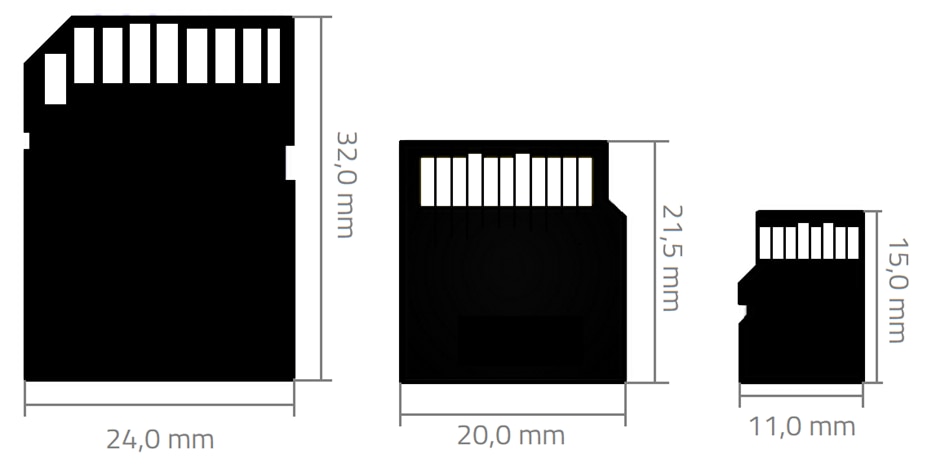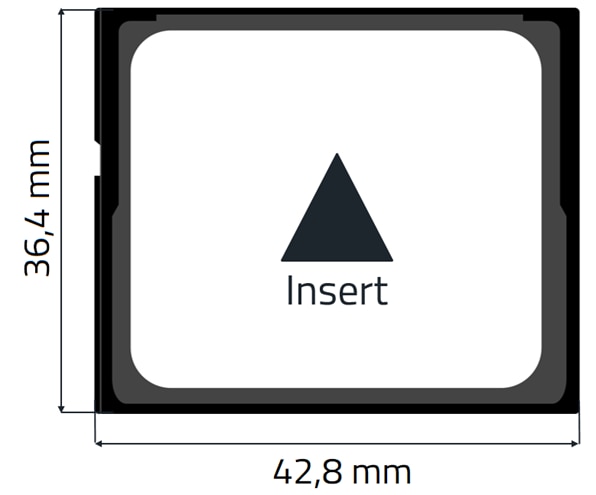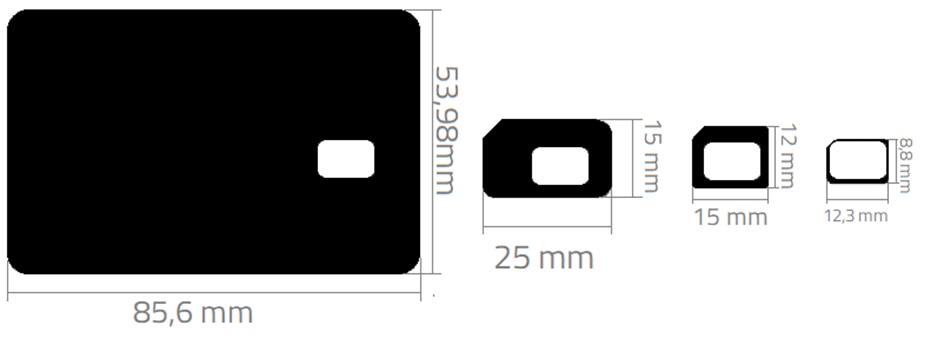Offline Memory Technology
Part 6: Modern Card Standards
By Baptiste Bouix
Last time, we have seen the evolution from cartridges to standardized card connectors. In this part, we will see three different modern card standards that have evolved from this history.
SD Cards
Secure Digital (SD) is a Non-Volatile Memory format developed by the SD Card Association (SDA) for use in portable devices. It was launched in 1999 to improve the MMC standard. SanDisk, Panasonic and Toshiba collaborated to create the SD Association in 2000. At the time, there was only one form factor for the SD card. The logo itself is a reuse of the logo created by Toshiba for the Super Density Disk.
A second form factor, the MiniSD, was born in 2003, and the next year the MicroSD. Both those form factors were electrically compatible with the standard SD form factor. You could use an adapter to put them in SD slots. The MicroSD became extremely popular in the rising smartphone and mobile devices market to expand the memory capacity.

Until 2006, SD cards could only support capacities up to 2 G of data, but the SDHC format launched this year allowed to ramp that up to 32 G. By 2006, MicroSD had supplanted all MiniSD from the market and this form factor was not produced anymore.
In 2009, the SD Association launched the SDXC, allowing memories up to 2 T. Ultra High Speed buses are also introduced in 2010, allowing transfer speeds up to 180 M/s if both the card and the host are equipped with such a bus. Next year the UHS-II allowed speeds up to 300 M/s. For that, the SD 4.0 standard introduced a new pinout for cards and connectors, with 8 additional high-speed contacts.
In 2017, UHS-III brought the speed to 624Mo/s using the SD 4.0-style pinout. In 2018, the SD Express reworks the 8 high-speed contacts in a single PCI Express lane working at 985 M/s. These SD Cards must also be compatible with the NVM Express interface protocol, turning them effectively into solid-state drives in their own right.
The SDUC standard, introduced in 2019, allows support for up to 128 To memories, and the 8th version of the SD specification from 2020 also adds extended PCIe Gen 4.0 capabilities.
SD cards generally use flash memory, specifically flash NAND.
CompactFlash Cards
The CompactFlash card is a derivative of the PCMCIA card. Its 50 pins is a reduction of the 68-pins PCMCIA card standards and are small enough to be fitted in other computer card slots with an adapter. It emerged in the early 90’s, with the first being manufactured by SanDisk in 1994 as a memory card system to be connected on various existing ports easily with an adapter. Coupled with the controller inside of the CompactFlash Card, it can emulate PCI, PCMCIA and IDE (or PATA) interfaces, making it one of the most versatile memory format.
In 2008, the CompactFlash Association announced the release of the CompactFast, with a SATA 24 pins interface using the same memory technology. The CFlash SATA can also emulate the PATA interface, but the two cards are not electrically compatible.

From 2010 onwards, research on a new card format was launched with the XQD format. This new format had 21 pins. In 2017, this card became the base for CFexpress, the latest evolution of CompactFlash based on PCIe gen 3 standard bus. The XQD form factor became the CFexpress Type B in 2019, along with the Type A and the Type C, the later being a form factor designed for solid state drive connectivity.
CompactFlash cards generally use flash memory, specifically flash NAND.
SIM Cards
A Subscriber Identification Module (SIM) card is a type of Smart Card (or ICC, for integrated circuit cards), described by ISO/IEC 7810 and 7816 standards. Unlike the more generic Smart Cards, SIM cards are used to carry the mobile identification to access wireless phone networks.
The Groupe Spécial Mobile (GSM) was started in 1983 to work on a European standard for cellular telecommunications. From 1989, the European Telecommunications Standards Institute worked on the Global System for Mobile Communications (also GSM) and established the SIM card standard. In 1991, the first SIM card was manufactured by Giesecke & Devrient, for the first GSM-based network of the Finnish Radiolinja operator. It was a full-size card, called 1FF (1st Form Factor), like a credit card.
The SIM card was carried over for all subsequent improvements in wireless phone networks, such as the GPRS standard, and the 3G, 4G and 5G technologies. The second form factor (2FF), the MiniSIM, was introduced in 1996. The MicroSIM (3FF) arrived in 2003, as room in mobile phones became a luxury. The NanoSIM (4FF) arrived in 2012. By then, it was not possible to reduce the card anymore; therefore, the standard introduced the eSIM in 2016, which involves soldering directly the SIM chip on the PCB.

SIM cards can provide identification, authentication, data storage, strong security authentication for Single Sign-On (SSO) and application processing. These integrated circuits are generally based on EEPROMs. SIM cards store the IMEI and other access codes to the mobile phone network. Smart cards contain non-volatile memory storage components and sometimes dedicated security logic. Microprocessor cards can also contain volatile memory and computing components that can be accessed with additional contacts. On a SIM card, this configuration is called MegaSIM.
Last words
The Würth Elektronik Trilogy of Connectors book that will be released this year will expand on the technical specificities of these standardized yet unique connectors to help you integrate them in your designs, and much more !

